#vdlr2013 – Racing sailors can be divided every which way. And one particular chasm emerges when you enthuse about the special pleasures to be derived from racing close along coastlines, and round rocks and islands, preferably with a bit of tide thrown in. Those of us who enjoy it find we're totally at variance with the sterile brigade on the other side of the great divide. These are people who are likely to be found in the ranks of Olympic sailing fans. They aspire to race on waters which are as current-free as possible, and well away from any wind deviation caused by bays and headlands.
They want clearly defined legs to prescribed formulae, and virtually unpolluted by the interaction of sea and land. But this interaction between sea and land is something which the rest of us find fascinating, and we feel it adds to the quality of the sport. Particularly so when the winds are light and summer is upon us. The Olympian idealists will want us to get out to sea, and remain pure if windless. But we coast crawlers, we lovers of local knowledge, have an often justified feeling that only by using the interaction of sea and land, and the tide too, will you be able to find enough breeze to provide for a spot of racing on a summer's day.
So it was that on Thursday's first day of racing for the Volvo Dun Laoghaire Regatta, we had some sailing that was as enjoyable as any I can remember. Yet it didn't look promising. The breezes were light in the extreme. And I'd secured a berth aboard the First 44.7 Lively Lady, which is owned by Derek Martin and raced by his sons Rodney and Keith with a crew of friends.
It didn't look promising because the Lady is a true cruiser-racer, complete with all the comforts, and chiming in at a hefty 9 tons even in racing trim. And though Rod and Keith had elected to race in the IRC Coastal Class which avoided the short-legged events in the bay which are a pain in any boat over 40 feet, they found they'd been joined in their choice to go coastal by the likes of George Sisk with his Farr 42 WOW, James & Sheila Tyrrell's J/133 Aquelina, Vincent Farrell with the First 40.7 Tsunami, and Liam Coyne with the First 36.7 Lula Belle, racing boats which could expect to outperform Lively Lady in light conditions. As for bigger boats, they included Stephen O'Flaherty's classic Spirit 54 Soufriere, which once upon a time starred in a James Bond movie, and Seamus Fitzpatrick's impressive Mermaid IV, one of the stylish new Beneteau 50s which, for old salts like us, look for all the world like a giant Firefly dinghy.
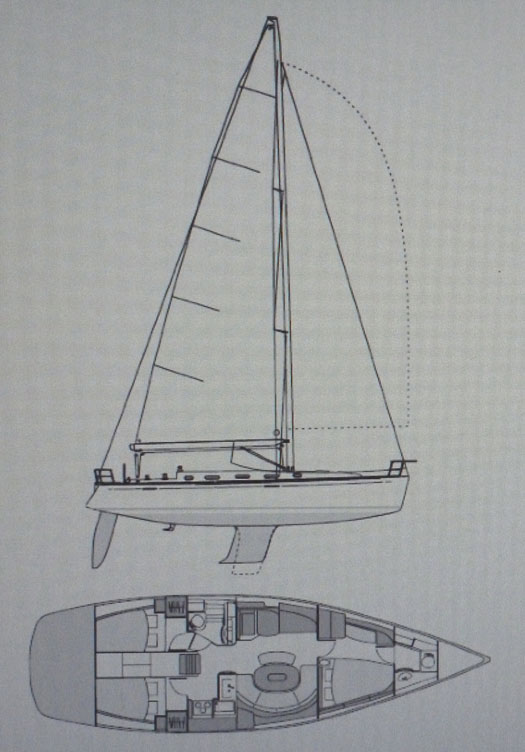
The First 44.7, introduced by Beneteau in 2004, is a notably comfortable cruiser-racer
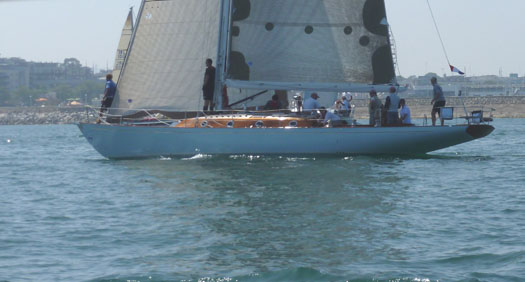
Stephen O'Flaherty's Soufriere is a "modern classic" Spirit 54 Photo: W M Nixon
So far from having a nice little jolly along the coast in leisurely style and back in time for tea, we were lined up against a good turnout of 16 boats, every last one of which was convinced this was her day. The course was a start out off Sandycove, then round the Muglins, south to the Killiney outfall buoy, then north to a race mark a mile or so west of the South Burford, then finally the Forty Foot race mark left to starboard, and finish back more or less to where we'd started. It was quite a big ask of 15.72 miles with a light southeast breeze and the tide just starting to ebb with vigour. But the breeze did seem to be building nicely as it curved round the headland at Bulloch, so Rodney set to his work punching it all into the keyboard.
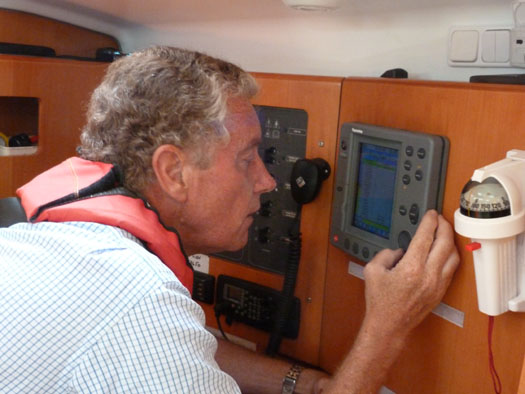
Get it into the machine – with high hopes, the skipper keys the course into the plotter
Photo: W M Nixon

Crowded action before the start Photo: W M Nixon

Things were looking very sweet just after the start Photo W M Nixon
We liked the start so much we did it twice. First time was nicely away, comfortably on starboard with the fleet neatly tucked in to lee. But then after the prescribed interval, the VHF squawked we'd been over the line. I didn't hear one bad word said about this, which makes Lively Lady a most unusual boat. And as for getting himself out of it, despite the boats from the next class milling about back on the start line, Keith on the helm somehow managed to get this suddenly enormous 44 footer back across against the tide, and then deftly hardened up on port tack and cleared the committee boat by a whisker (she was the catamaran, Spirit of the Irish, and came within an ace of becoming two monohulls) and started making knots on port tack towards the Sandycove Martello tower.
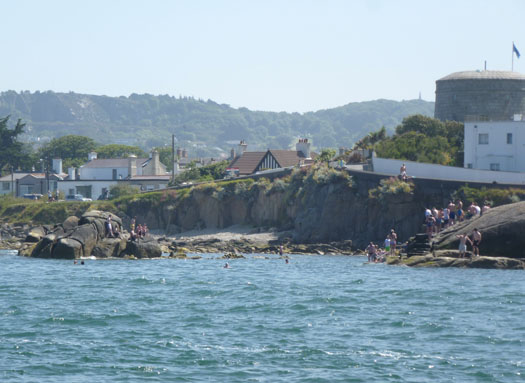
Close racing with the Forty Foot at Sandycove Photo: W M Nixon
In racing in Dun Laoghaire regattas of yore, I'd always been told that when the wind is southeast, regardless of the tide if beating down towards Dalkey, you "go for the wall". Usually it would be in one of those grim rain-bearing sou'easterlies. But this was fun, sweeping in past little angling boats in the bright sunshine and close by the crowded Forty Foot at top of the tide. It was the way we'd meant to go once we'd settled onto the race. But with the recall, there was now real urgency to it, while the rest of the fleet, sluicing seaward on starboard tack with the ebb, somehow let us away with it for long enough to get Lively Lady back in the hunt.
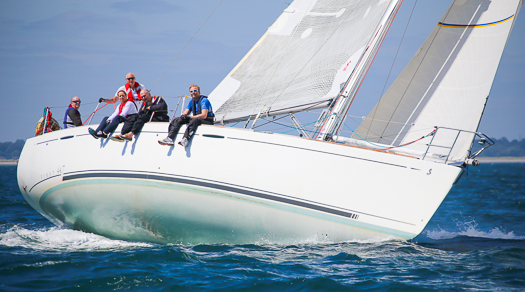
Lively Lady is at her best when the breeze gets above 15 knots, but it never got anyowhere near that on the first day of the VDLR Photo: David O'Brien
In twenty-five minutes, she went from Zero to Hero. Let's face it, at our second start we were dog last. But there was just enough breeze to bring her to life. I'm told she really comes into her own when the breeze climbs above 15 knots, but along the shore we found just enough bite to get her moving well, and by keeping inshore of just about everyone else we could pick our way along the coast in clear wind, going great guns.

Going to the wall – by holding close along the shore in a private breeze, we got back in the hunt Photo: W M Nixon
It was a very neat calculation as to when to take the final tack right inshore to zap out on starboard along the northeast rocks off Dalkey Island for the turn at the Muglins. We were carrying private breeze by this stage, and closed in to the Muglins with only WOW and Soufriere still ahead. This is where an interesting bit of sailing became utterly fascinating. WOW was still quite well clear, but Soufriere only just got across on port, yet she seemed to be going well and was clearing the Muglins comfortably to shape her course on into Killiney Bay.
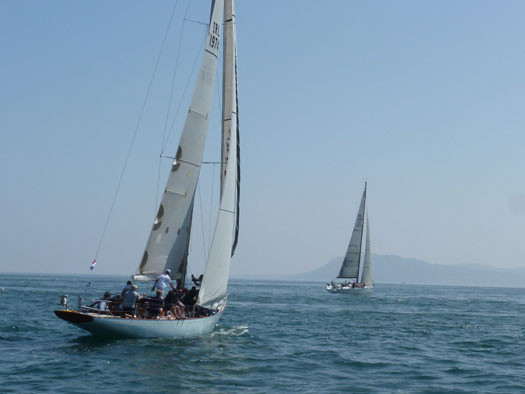
WOW is clear ahead of Soufriere south of the Muglins heading towards Killiney Bay Photo: W M Nixon
But in those tidal conditions, there were distinct tidal shadows south of both the Muglins and Dalkey Island. Normally their relative effects would be small, but in that light breeze, tide was everything. We'd tacked to keep ourselves well clear of Soufriere and out of WOW's lee. Soufriere looked to be doing the business, but then got into the tidal shadow downstream of the Muglins. Relatively speaking, she came to a halt, and soon was joined in her parking place by the First 40.7 Tsunami.
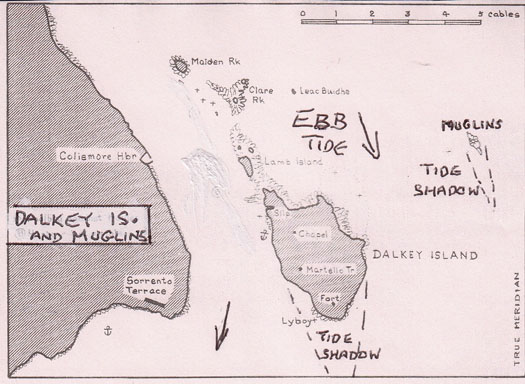
The tidal shadows to the south of the Muglins and Dalkey Island during the ebb play a significant role in racing in the area.
By the time Soufriere had got back into the south-going tide between the Muglins and Dalkey Island, we were abeam of her and quite well south. But then she found a stronger run of tide as she neared Dalkey Island, and seemed to be making hay. Alas, then she hit the much larger tidal shadow south of Dalkey Island, and its stopping effects were exacerbated by the local wind cushion. In other words, they were in both the tidal lee, and the localised calm usually found to weather of a steep coast. That was the end of Soufriere's race.
Meanwhile, with the wind lightening, other boats were coming along towards the Killiney turn with the help of the tide, which lessened the nearer you got to the mark, while the wind as usual was dying in Killiney Bay. But let's get this straight. The authorities don't like it being called the Killiney Outfall Buoy. It must be bad for property values in this elite area, or something like that. So they prefer it to be called the Shanganagh Buoy. That's what is says on the tin. And we can vouch for it, as we spent some time studying it.

We spent quite some time confirming that it is officially called the Shanganagh Buoy. Photo: W M Nixon
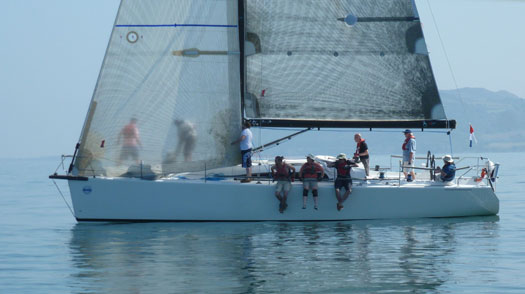
Transparent foredeck work on WOW. Photo; W M Nixon

Aquelina was the first to catch the short-lived new breze. Photo: W M Nixon
In fact, we anchored beside it the better to view it in detail, and so did several others as the tide, coupled with the total absence of wind, wanted to carry us down to the next outfall buoy of Bray. You can have too many outfall buoys in one day, so we kedged. But the water authorities will be delighted to hear that, despite the clearly advertised proximity of the outfall, several crews from most boats went for a swim. Their shipmates meanwhile struggled to harness every zephyr, and when Aquelina's gossamer-like gennaker started doing the business, she headed purposefully for the next though distant mark close aboard WOW, with Lively Lady struggling to stay in the game setting a plain bog standard spinnaker which has sailed many miles since Des McWilliam made it a very long time ago.
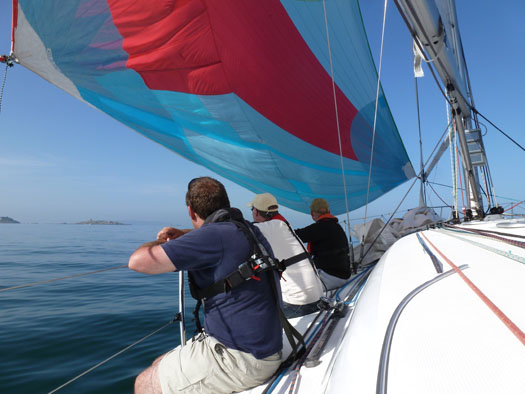
The veteran spinnaker did its best to keep us in the hunt Photo: W M Nixon

The new Beneteau 50 looked to old salts like a giant Firefly as she glided along in Killiney Bay Photo: W M Nixon
By this stage it was all a matter of sportsmanlike gestures, for although the committee boat had been re-stationed to finish a shortened course at the race buoy out towards the South Burford, there was no way anyone in our class was going to get there within the 1900 hrs time limit. Truly, the Curse of Killiney was upon us. For, way beyond the Muglins of happy memories, we could see hundreds of sails flitting hither and thither as the other fleets enjoyed a sailable wind in the bay, and they managed a complete programme despite the light breezes.
As for ourselves, we were later asked to furnish our times at the Killiney Shanganagh whatever buoy. Rodney being a righteous and devoted adherent to the Code of the Martins, he had taken the time we'd actually rounded the buoy. That was maybe all of an hour after our bow had actually passed it when heading south. Had that earlier time been taken by a RIB thoughtfully placed at Shanganagh to provide a finish line (ain't hindsight a wonderful thing), who knows, but we might even have won.
But better a moment as an eagle than a day as a sheep. We'd had our glorious 25 minutes between our second start and the turn at the Muglins, and we'd been very much in the hunt at Shanganagh. We returned to a harbour resplendent in summer style, with rowing skiffs in action (do all the women crews have male cox'ns?) and for the first time ever, I saw the historic Waverley 18 footer Durward – the smallest keelboat ever to sail round Ireland – sailing in the harbour instead of lying to her moorings as usual off the George. It was truly summertime, something in itself to be celebrated.
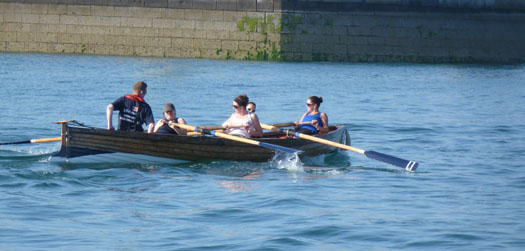
Dun Laoghaire on a summer evening. Do the female skiff crews only allow themselves to be shouted at by male coxes? Photo: W M Nixon
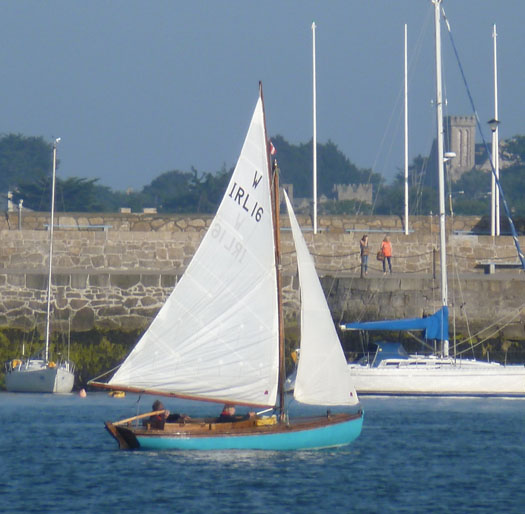
Heroine of the high seas – the Ireland-girdling 18-footer Durward out for a summer sail Photo: W M Nixon
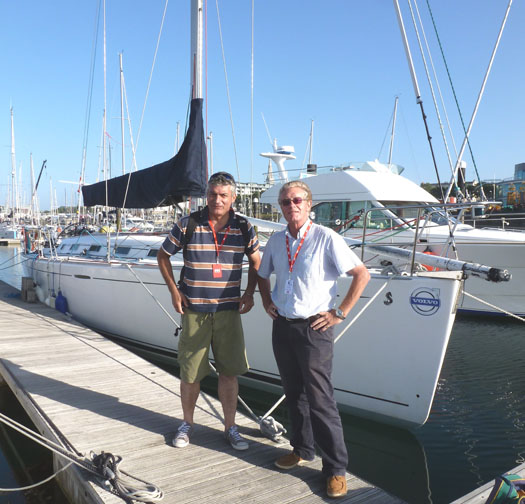
End of an intriguing day afloat – and "still talking to each other". Brothers Keith and Rod Martin with Lively Lady. Photo: W M Nixon
Lively Lady's home club is the Irish, and we got there to find the place heaving. As well it might - they'd every right to party, as RIYC boats had won in half a dozen classes. Despite their own success, some kindly souls were even prepared to listen to an abridged account of how Lively lady went from Zero to Hero in 25 minutes flat.. We in turn listened to thoughtfully detailed accounts of their own wonderful achievements afloat. And everybody was having a lovely time.
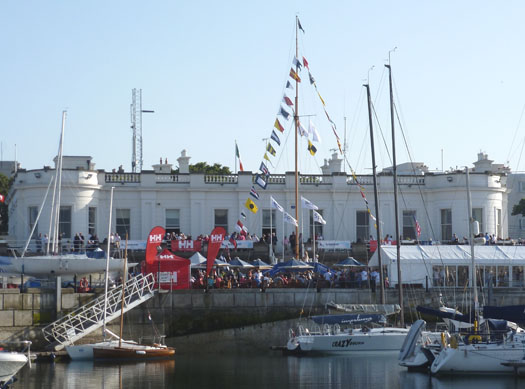
"The joint was heaving". Party time at the Royal Irish YC in Dun Laoghaire on the first evening of the VDLR. Nobby Reilly & Alan Chambers Crazy Horse (foreground) had won Class 0 racing in the bay. Photo: W M Nixon
































































